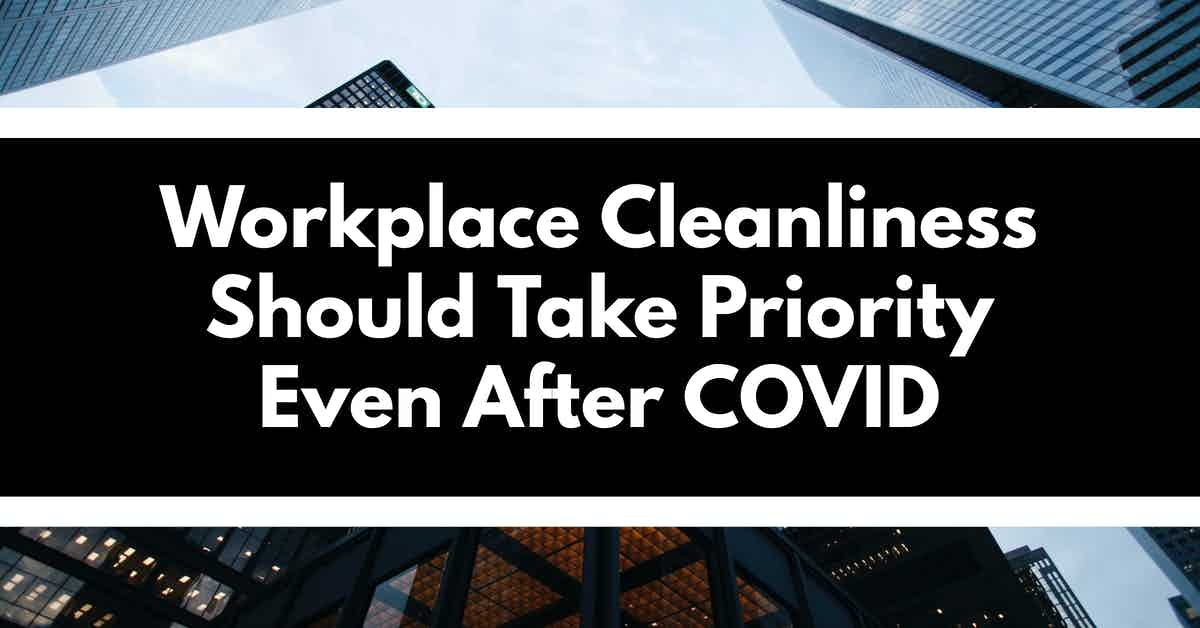High levels of workplace cleanliness improve employee wellness, reduce absences, increase positive online sentiment, and establish an environment of wellbeing that is crucial for occupant productivity and job satisfaction.

Why Workplace Cleanliness Must Take Priority Well After the Pandemic
Workplace cleanliness has a direct impact on:
- Occupant health and wellness.
- Consumer impressions and feedback, and;
- Workforce effectiveness.
Prior studies have found that the average office workspace contains hundreds to thousands of potentially disease-causing microbes per square inch, contributing to more than five sick days and $1,700 in lost productivity per US worker each year.
According to BizTimes;
The average desk hosts 800 bacteria per square inch. That’s nearly 15 times more bacteria than what’s on a toilet seat (there’s about 59 bacteria per square inch on a toilet seat).
Your desk phone can contain an estimated 1,600 bacteria per square inch.
Still not adding up? In 2015, the Centers for Disease Control and Prevention found that productivity losses linked to workplace illness cost employers nearly $1700 per employee.
A routine cleaning program combined with an antimicrobial treatment can reduce cross-contamination and keep your employees feeling healthier at work.
3 reasons workplace cleanliness should take top priority even after coronavirus
Post-COVID, the majority of office workers have stated a strong preference for improved cleaning and sanitization methods and increased cleaning frequencies.
According to PeopleReady;
In a recent Deloitte survey of employees, 64% said that “regular cleaning of equipment and shared spaces by a cleaning service” is important for them to feel comfortable going back to work.
Having a regular cleaning schedule with specific checkpoints can keep your employees and your work environment safe.
A driving force behind workforce demands for increased cleaning frequencies and quality is pre-COVID office worker behaviors that contributed to the spread of illness.
According to a pre-COVID survey conducted by Staples:
- 80% of employees were going to work sick.
- 73% caught a cold or the flu at work.
- 32% blamed their coworkers for getting sick.
- 67% believe an employee going into work sick but not fully productive is worse for a business than an employee who stays home and doesn't work when sick.
- Only 48% of employees said their office provides sanitizing wipes to clean work surfaces, and;
- 52% of respondents said going to work sick makes them "hardworking and committed."
Source:
How to Ensure Ongoing Workplace Cleanliness
The workplace should be cleaned every day it is occupied and deep cleaned at least once per month--more depending on the number of occupants, the potential for the spread of disease, and the nature of the industry your organization operates in.
Commonly touched surfaces, such as door handles and publicly accessible touch screens, should be wiped down with a disinfectant several times per day--increasing with the number of occupants that contact the surface and the presence of any infectious diseases in the local community.
Hand sanitizer stations should be placed around the office and near entrances with signs encouraging their use.
Restrooms should be spotless, free of debris, and fully stocked with soap and paper products to encourage regular handwashing.
Workers should be issued sanitizing wipes for their workstations and encouraged to wipe down computer equipment, desks, and phones before the day starts and after it ends.
Additionally, workers should be discouraged from eating in their offices at their desks.
Waste removal should be performed at least daily.
Assigning day porters to check restrooms and trashcans will ensure compliance and higher standards of safety and cleanliness.
Windows, blinds, and light fixtures should be dusted and cleaned as needed to eliminate the presence of dust which negatively impacts indoor air quality and can contribute to asthma-like conditions or sick building syndrome.
Floors, which are commonly overlooked, should be swept, mopped, or vacuumed every day the facility is occupied to minimize wear and tear, remove soil and hazardous chemicals, and reduce the spread of pathogens and pathogenic bacteria.
Services should only be performed by trained professionals using the latest in technologies and well-maintained equipment.
The failure to adhere to proper custodial service provider training standards will likely result in the spread of dangerous toxins and disease.
Takeaway
Workplace cleanliness must continue to take precedence in the office well after COVID has run its course.
Office workers are demanding it, and a strong motivator driving that demand is a long and documented history of poor workplace etiquette regarding illness.
Encouraging high standards of workspace cleanliness, hand hygiene, and promoting the idea of staying home when you are sick will significantly improve occupant productivity while reducing the number of preventable sick days the average US office worker takes each year.
Outsourcing is a proven method for cost-effectively onboarding in-demand cleaning skills and technologies at a fraction of the cost of managing the same service level in-house.
If you would like more information regarding the effectiveness of high-performance infection prevention and control measures, or if you would like to schedule a free, no-obligation on-site assessment of your facility's custodial needs, contact us today for a free quote!
In Bakersfield, CA, call (661) 437-3253
In Fresno, CA, call (559) 206-1059
In Valencia, CA, or Santa Clarita, CA, call (661) 437-3253
In Palmdale, CA or Lancaster, CA, call (661) 371-4756

